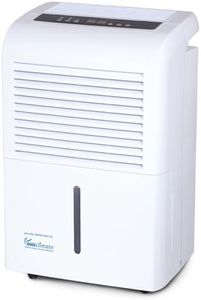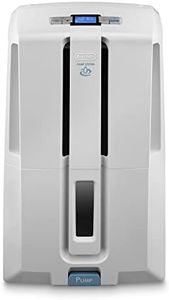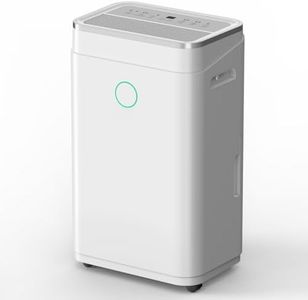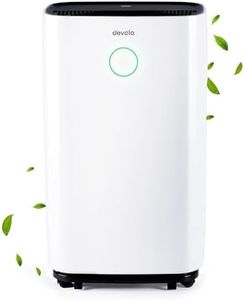We Use CookiesWe use cookies to enhance the security, performance,
functionality and for analytical and promotional activities. By continuing to browse this site you
are agreeing to our privacy policy
5 Best Dehumidifier With Pump
From leading brands and best sellers available on the web.Buying Guide for the Best Dehumidifier With Pump
Buying a dehumidifier with a pump can make managing humidity in your home much easier, especially if you need to remove moisture from larger areas or basements where draining water manually is tricky. Dehumidifiers with pumps can automatically move the collected water to a drain or out a window using a hose, saving you the hassle of emptying a tank repeatedly. When choosing the right one for your needs, you’ll want to look at a few important features to match the size of your space, the amount of moisture, and your convenience preferences.Capacity (Pints per day)This measures how much moisture the dehumidifier can remove from the air in a 24-hour period, usually listed in pints. This is a key factor because a unit that’s too small won’t be able to keep up, while one that’s too large might use unnecessary energy. Generally, smaller spaces or slightly damp conditions need a dehumidifier with a lower capacity (around 20-30 pints/day), while medium spaces or wetter conditions might need something in the 30-50 pint range. Larger, very damp spaces like basements often do best with devices that handle 50 pints or more a day. Think about your room size and how damp it typically gets — use that to determine which capacity category fits your needs.
Pump Function/Drain HeightThe built-in pump makes it easier to automatically push water to a drain, sink, or even out a window. The drain height tells you how high the dehumidifier can pump water upward, which is essential if your drain is above the unit (like a utility sink or a high basement window). Lower drain heights (up to 10 feet) are enough for most situations, but make sure the pump can manage your particular setup. Check where you plan to run the hose and consider how high the water needs to travel; match that to the pump's capability.
Coverage Area (Square Feet)This tells you how much space the dehumidifier is designed to handle. It’s usually given in square feet, and you’ll want a model that matches or slightly exceeds the area of the room or basement where you plan to use it. Smaller units cover 500-1000 sq. ft., mid-range models are good for 1000-2000 sq. ft., and larger units can manage even bigger spaces. To pick the right one, measure your space and check the manufacturer's recommendation for square footage. Don’t go too small, or the device won’t effectively remove enough moisture.
Tank SizeEven though the pump allows continuous drainage, the tank size is still worth noting in case the pump fails or you choose not to use it all the time. A larger tank means it can hold more water before needing to be emptied, which is helpful during times of heavy humidity or pump issues. If you plan to rely fully on the pump, the tank size is less crucial, but for added peace of mind, a moderate to large tank can be a useful backup.
Noise LevelDehumidifiers make some noise as they operate. Noise level is measured in decibels (dB); lower numbers mean quieter operation. For bedrooms or living spaces, quieter models are ideal (often advertised as below 50 dB). Louder units might be acceptable for basements or utility rooms. Think about where you'll use the dehumidifier most, and if you’re sensitive to sound, make noise level a priority in your decision.
Auto Restart and HumidistatAuto restart ensures the machine will turn back on by itself in case of a power outage, which is especially useful for basements or second homes. A built-in humidistat lets you set the desired level of humidity, and the machine will cycle on and off to maintain it. For those who want hassle-free humidity control, look for models with an accurate humidistat and reliable auto-restart, so you don’t have to monitor the dehumidifier constantly.
Filter Type and MaintenanceMost dehumidifiers use filters to catch dust and airborne particles. Some offer washable filters, while others need periodic replacement. Filters not only protect the machine but also improve indoor air quality. Choose one with easy-access, washable filters if you prefer less ongoing effort, or be ready to buy replacements as needed. Check how often maintenance is needed and what fits your comfort with DIY upkeep.




